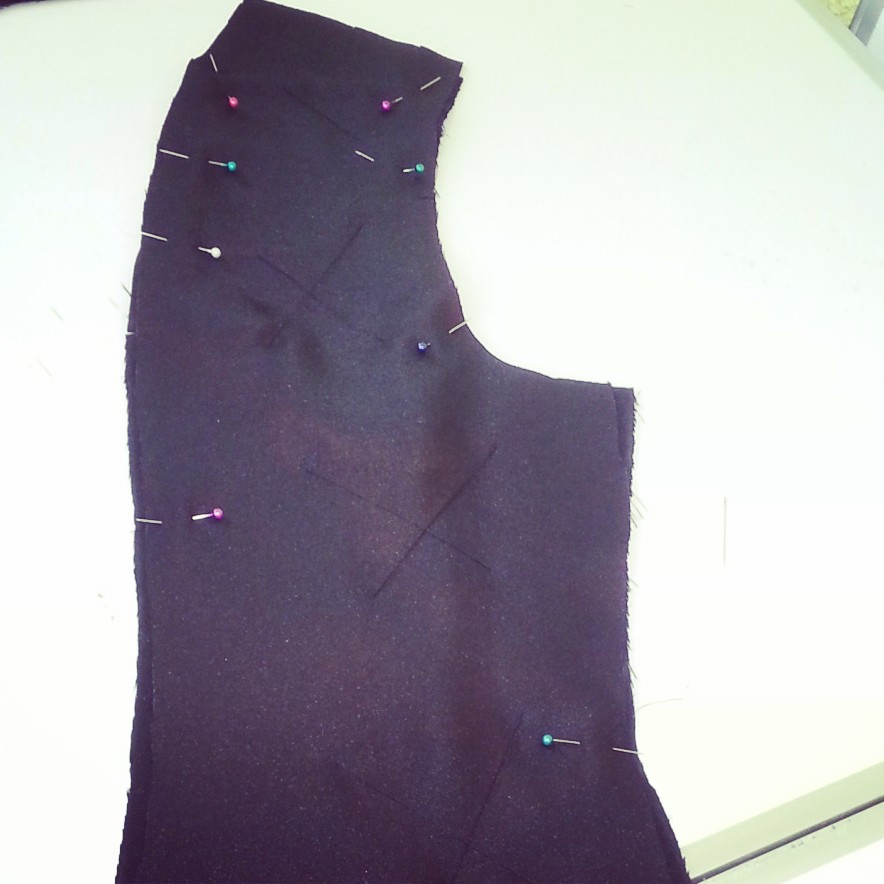This is part 3 of my mini series on the Chanel jacket course I attended in March.
See here for part 1 about inspiration and here for part 2 on materials!
Today I’m sharing my progress from day 1 of the course.
I packed up my machine, pattern, fabric, notions and a travel sewing kit and set off to Roundhay!
Gillian the course instructor advised making a toile with at least one sleeve set in and bringing it along for discussion on the first day.
I traced all my pieces rather than cutting as I was sure I’d need to apply some “creative” sizing.
I traced a size 12 at the neck/shoulder/armhole/bust and graded out to a size 14 waist and 16 hip.
What I ended up with was pretty good I think. The shoulder length/armhole needed some adjustment but the fit across the bust waist and hips felt good. For a non-fastening jacket the fronts meet and it doesn’t gape open too much.
Overall I felt it could have been snugger and Gillian agreed. She also helped me remove 3cm length from the sleeve.
She advised that although the toile is an excellent indicator of fit it’s often better to fit the jackets again mid-construction because of the wool behaving differently to calico.
Down to business. First up we cut out fabric and lining pieces, remembering to take into consideration nap, pattern matching and in my case the one way shine of satin. I didn’t use interfacing in the end as my wool had enough stability.

The construction was not as expected. Instead of constructing the outer shell and lining separately and the attaching the two, the corresponding shell and lining pieces were basted together and machine quilted.
This took the majority of the day. We chatted as we went and I made the most of the tips that were shared ready for when I make my second jacket. Here’s a few things I took note of:
- For a truly expensive looking jacket it’s not enough to pattern-match your fabric in the seams and the sleeves, you should also be matching the pockets.
- An inch of seam allowance helps you be safer rather than sorry with expensive fabric.
- Don’t overpress your fabric… in fact barely touch it! Wool is most likely to show marks where you’ve squashed it.
- It’s not worth overlocking your pieces even if they’re fraying like no-one’s business, as you’re just creating bulk at the seams and wool is plenty bulky enough! Just pink the edges if you need to do something.
Sorry it’s taken so long to post this. I’ve just started a new job and also Mr AR has been unwell. More excitement drafted and ready to post in Part 4 about day 2 of my class.


Oh! I so can’t wait to see more posts on this! Great tip about the not serging the edges. I start freaking if they fray and overlock them into safeness. Then there is always seam bulk. Grrr. Pinking all the way!
True dat! My flat is covered in black fluffy threads though.
I’ve been searching your blog for the finished jacket. Are you still working on it?
Hello! I did everything but add the trim but then looked at it and went what a dark black jacket! Why didn’t I make a colourful or tweed one?! So I’m soon to start jacket v2.0. I should really finish my posting though shouldn’t I. Terrible form, I’m sorry.
Just curious! I want to start one soon and am looking for inspiration. Did you see Marina’s Chanel jacket at Frabjous Couture? All black, with an interesting black trim. Perhaps some sparkle could brighten yours?
That’s a good idea. I’m helping my mum make a coral version soon. I suggest you go bright with yours. Will make you happy when you wear it
http://www.coutureschmiede.com/2011/06/my-chanel-inspired-jacket-pics.html